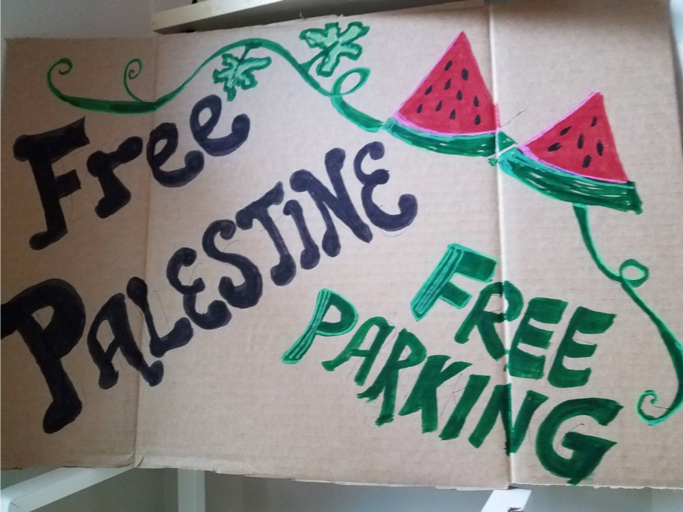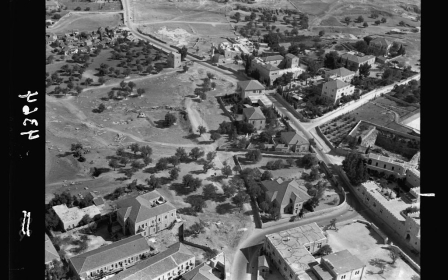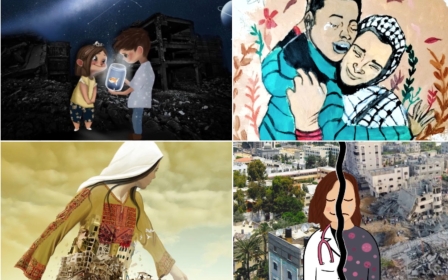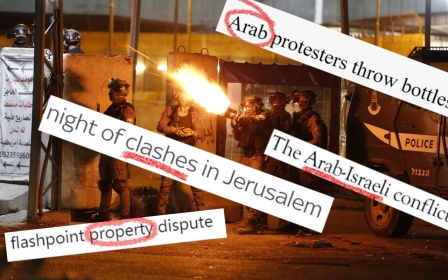Memes, jokes and icons: Eight ways Palestinians are resisting the occupation online
Since Israel threatened to forcibly remove Palestinians from their homes in Jerusalem's Sheikh Jarrah and Silwan last month, triggering a wave of protests followed by violent retaliation from Israeli forces and armed settlers, Palestinians have taken to social media to fight the occupation.
There have been the continuing traditional online campaigns to educate the non-Palestinian public on events as they happen, spearheaded by advocacy groups like al-Shabaka, Jewish Voice for Peace and the Institute for Middle East Understanding (IMEU), as well as on the history of Palestine. But the online realm has also seen Palestinians and those who support them envision new ways to advocate for Palestinian liberation, including using visual symbols, memes, jokes and parodies.
In resisting Israeli occupation, Palestinians have often looked to the past for inspiration. The watermelon has long been a symbol of Palestinian resistance, as have keys, symbolising the right of return for Palestinian refugees. Other symbols, especially recently, have been born in digital spaces, out of debate and conversation, but often with a link to the past.
New MEE newsletter: Jerusalem Dispatch
Sign up to get the latest insights and analysis on Israel-Palestine, alongside Turkey Unpacked and other MEE newsletters
New symbols crop up almost daily on social media to adapt to the changing reality on the ground, where Palestinian families have recently been served demolition notices in the Jerusalem neighbourhoods of Silwan and Sheikh Jarrah and Palestinian protesters have been attacked by the Israeli military. Gaza, which endured 11 days of Israeli bombardment, is struggling to rebuild.
Some of these symbols only circulate for a few days, some circulate then resurface and some will endure. There is therefore an urgent need to document them and their context: if Palestinians are drawing on past resistance for strength and creative inspiration, this moment in history also needs to be documented.
Documenting this history of resistance to the Israeli occupation is for the Palestinian people first and foremost. It will give the next generation of Palestinians a historical record of their own, created by their own people, to use not only for continuing the tradition of creative resistance work, but for future generations to discover.
1. The Palestinian flag
The Palestinian flag remains the most popular way to express Palestinian solidarity, even when the Israeli occupation criminalises raising or waving it.
Palestinian flags have been incorporated into graphics and are drawn by children to raise morale.
The Palestinian flag emoji has long been a way to demonstrate one's nationality, especially on spaces such as Twitter and Instagram, where space might be tight for much description.
The situation has evolved over the last few months, with the flag emoji becoming more frequently used by non-Palestinians to show solidarity with the cause. This has led some Palestinians to discuss whether they find it appropriate for non-Palestinians to use the emoji, with many arguing that Palestine’s visibility takes precedence.
2. Watermelons
The watermelon has been a symbol of Palestinian resistance since the 1980s, after Israel banned the use of the Palestinian flag anywhere in the territories it occupies.
The watermelon was used by Palestinians instead, as it contains the colours of the Palestinian flag: red, black, green and white.
In May 2021, graphics emerged reminding people of the symbolism of the fruit: how artists such as Sliman Mansour incorporated the watermelon into their artwork; and how ordinary Palestinians carried slices of it to protest against the Israeli occupation.
This viral graphic and text by Instagram artist gaytor_al explains the history, based on a conversation with iconic Palestinian artist Mansour.
Graphic designer Basmah Kishta created a graphic with watermelons, accompanied by the text #Qawim, or resist. And Mansour himself has been posting some of his art from the 1980s which used the watermelon motif to bypass censorship.
Palestinian artist Michael Halak produced a parody of Maurizio Cattelan’s 2019 Banana art pieces, which famously went viral. Instead of a banana, he taped a slice of watermelon to a wall with blue tape and is selling it through the Tabari Artspace gallery, with proceeds going to the Palestinian Children’s Relief Fund (PCRF).
Native Threads, a streetwear collective, recently used watermelon motifs in their work, fundraising for Palestine.
The watermelon emoji 🍉 has also been incorporated into text messages, tweets and more.
3. Free parking
On 24 May, Scottish music journalist Eve Barlow tweeted: “My Jewish friend saw a sign that said FREE PARKING and panicked that it said FREE PALESTINE. The Jews are tiiiiiiired.”
Her tweet was eventually deleted, but not before it had been turned into a meme. People produced their own variations on Twitter, swapping out different words. For example: "My dog trainer friend saw a sign that said FREE PARKING and panicked that it said FREE BARKING. Trainers are tiiiiiiired”; or “My Palestinian friend saw a sign that said DEAD END and thought it said SHEIKH JARRAH IS A REAL-ESTATE DISPUTE. Palestinians are tiiiiiiired.”
"Free Parking" turned into a symbol on its own, turning up on protest signs, tweets in support of Palestine and more - sometimes combined with the watermelon.
No matter what its application, the "Free Parking" meme shows us how anti-Palestinian rhetoric can be turned into a symbol of resistance, through both its humour and innovation.
4. Tweet as if Palestine is free
The hashtag "Gharid Ka’anaha Hurra" (in Arabic meaning "Tweet as if Palestine is free") took off again in early June 2021, with Twitter users tweeting as if Palestine was free. The hashtag has appeared multiple times in the past, as Twitter user Nour Gaza notes.
More recently, tweets have expressed the desire to be able to move freely from Lebanon to Syria to Palestine, to use Gaza’s airports, to have breakfast at al-Aqsa, and going with family members who fled in 1948 back to their lands.
The hashtag gave Palestinians some room away from the forced evictions and Israeli violence in Silwan and Sheikh Jarrah, mass arrests and raids, and the blockade of Gaza, and a space to imagine and joke a little about the future.
It also created a space where Palestinians who have been prevented from even visiting Palestine could imagine their futures.
Non-Palestinians got involved as well, tweeting about freedom of movement between Syria, Lebanon, Palestine, Jordan and Egypt.
5. Altered infographics
US actress Debra Messing tweeted out a series of infographics urging people to understand “disinformation about Israel”, including criticising the use of the term “ethnic cleansing”.
These were quickly criticised for being anti-Palestinian and social media users used the same templates to create their own infographics.
In them, they criticised the use of the term "indigenous", placing the words “My grandparents are from Europe but I am indigenous to Palestine” in the bubbles instead.
6. Iconic graphics
The el-Kurd family of Sheikh Jarrah has been thrust into the spotlight over the last few months and has shown the world what is happening in their East Jerusalem neighbourhood, even when mainstream media has failed to do so.
Twins Muna and Mohammed el-Kurd use Twitter and Instagram to document their pending displacement, but their father Nabil has also become an icon, beginning with the posting of a picture of himself next to graffiti on the wall of their home reading lan nirhal ("We will never leave").
Since then, various graphics of him have gone viral, including this one, made by Palestinian graphic artist Hiba Yassine. It is an adapted image of the photos of him next to the graffiti, produced in the style of Palestinian folk art.
Another graphic was made by Palestinian graphic artist Haya Fanni, adapted from a photo of Nabil el-Kurd sitting in Sheikh Jarrah.
Nabil was later photographed outside a police station in Jerusalem protesting against his children’s arrests in June 2021, sitting on a plastic chair that he'd brought himself. The photo went viral and was a rallying call for the social media campaign for the Kurds’ release
The Kurd twins themselves have been the muse for many a graphic designer, with their likeness being used for motivational graphics. One of these, from an unknown source, went viral when Muna was arrested in June 2021. Featuring a vague outline of her torso and head, it quotes her saying "Khafish" ("Fear not"), which she said to her family when she was being taken into Israeli custody.
Watan also created a graphic of both of the twins, with lan nirhal scrawled across.
7. Celebrity support
The Palestinian-American Hadid family - models Anwar, Bella and Gigi - and singer Dua Lipa have become icons among the Palestinian digital community for their social media and real-life protesting in support of Palestine. As a result, they have attracted smear campaigns from both the Israeli state and its supporters.
Partly in response to the backlash, memes and graphics have been created to acknowledge Dua Lipa and the Hadids' support for Palestinians: Bella Hadid was even photographed at a protest in New York City.
This one - a take on the popular Twitter meme “I’m going to tell my kids this…” - uses a picture of Bella, Dua, Gigi and Gigi’s partner, Zayn Malik, walking down a street at night. Memes included “Gonna tell my kids this was Hamas” and “Gonna tell my kids this was the PLO”.
Artist Adige Batur also used Bella Hadid’s image to thank her for her support of Palestine, by layering it with a popular map of Palestine.
The cover of Dua Lipa’s 2020 album Future Nostalgia was edited to include the Palestinian flag, and well-known satirist and Instagram user Jean.paul.za3tar put Dua, Gigi and Bella on a Powerpuff Girls graphic.
8. The broom
Again, humour has been a large part of Palestinian resistance and when Israeli soldiers in Jerusalem confiscated a broom, the video went viral. Israeli soldiers frequently confiscate everyday items, such as flags or brooms, with very little justification, aimed at provoking Palestinians.
Palestinians tweeted inqadhu al-maknassa (which in Arabic means “save the broom”), or al-hurriya lil-maknassa, meaning "freedom for the broom".
The meme resurfaced again on 15 June when Palestinians were prevented from accessing the Old City of Jerusalem because of an Israeli settlers' march through the Old City, with brooms used by Palestinians to clean up the Damascus Gate area after the settlers marched, chanting as they did “Death to Arabs” and “The second Nakba is coming”.
It functioned as a way to parody their own attempts at raising awareness for different Palestinians who have been arrested, but more importantly, to critique the Israeli occupation, where even a broom was suspect.
This article is available in French on Middle East Eye French edition.
Middle East Eye delivers independent and unrivalled coverage and analysis of the Middle East, North Africa and beyond. To learn more about republishing this content and the associated fees, please fill out this form. More about MEE can be found here.






